Tracing the Source of Hydrothermal Fluid in Ophiolite-Related Volcanogenic Massive Sulfide Deposits: A Case Study from the Italian Northern Apennines
Abstract
1. Introduction
2. Geological Background
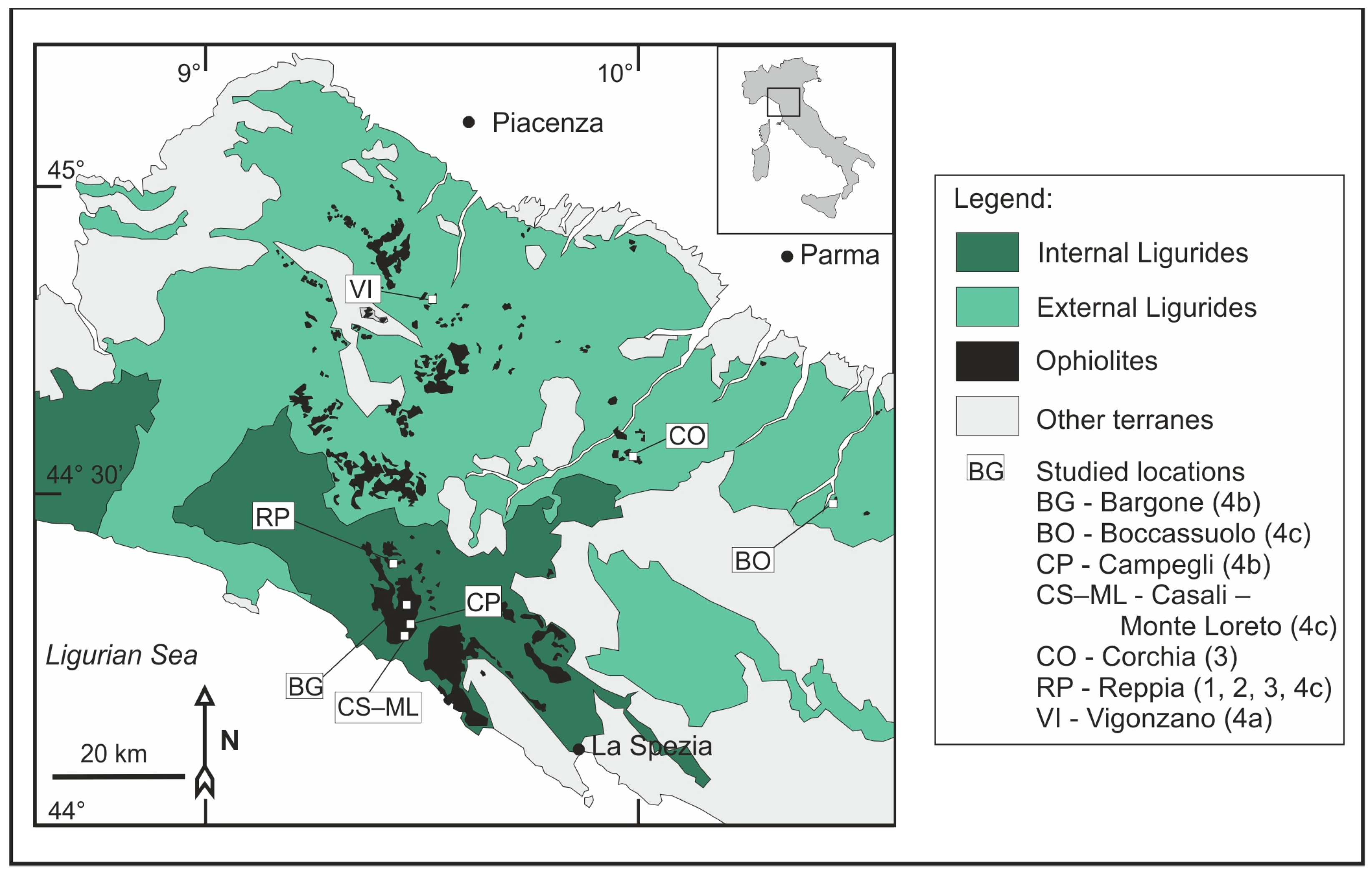
3. Materials and Methods
4. Results
4.1. Massive Sulfide Lenses
4.1.1. Texture and Mineralogy
4.1.2. Fluid Characteristics
4.1.3. Stable and Noble Gas Isotopic Composition
4.2. Stockwork Mineralizations
4.2.1. Texture and Mineralogy
4.2.2. Fluid Characteristics
4.2.3. Stable and Noble Gas Isotopic Composition
5. Discussion
5.1. Formation Conditions, Fluid Characteristics
5.2. The Source of the Hydrothermal Fluid
6. Conclusions
Author Contributions
Funding
Data Availability Statement
Acknowledgments
Conflicts of Interest
Appendix A
| VMS Massive Sulfide | VMS Stockwork | |||||||||
|---|---|---|---|---|---|---|---|---|---|---|
| Corchia | Reppia | Bargone* | Boccassuolo* | Campegli* | Casali | Monte Loreto | Reppia* | Vigonzano* | ||
| Coarse-grained quartz (Qtz 1) | Th (°C) (core) | 170–270 | 170–225 | 150–205 | 290–330 | |||||
| Th (°C) (rim) | 135–180 | 125–180 | 120–160 | 260–310 | ||||||
| Salinity | 2.6–5.7 | 2.6–4.7 | 3.1–3.9 | 7.2–9.3 | ||||||
| CH4 | x | 0.13–0.22 | x | x | ||||||
| n | 53 | 58 | 70 | 18 | ||||||
| Coarse- and medium-grained quartz (Qtz 1–2) | Th (°C) | 150–360 | 110–180 | 110–190 | ||||||
| salinity | 3.3–8.3 | 3.7–4.6 | 2.2–3.5 | |||||||
| CH4 | 0.19–0.26 | 0.04–0.05 | 0.12–0.13 | |||||||
| n | 98 | 71 | 122 | |||||||
| Medium-grained quartz (Qtz 2) | Th (°C) | 127–178 | 110–158 | 122–171 | ||||||
| Salinity | 2.12–3.26 | 3.1–4.7 | ||||||||
| CH4 | 0.32–0.34 | x | 0.22–0.33 | |||||||
| n | 48 | 9 | 41 | |||||||
| Fine-grained quartz (Qtz 3) | Th (°C) | 69–91 | 107–118 | 80–160 | 50–125 | |||||
| CH4 | ? | ? | x | ? | ||||||
| n | 6 | 3 | 15 | 5 | ||||||
| Calcite | Th (°C) | 49–93 | 110–135 | 60–160 | 132–169 | 95–156 | ||||
| Salinity | 2.41–4.18 | 3.1–6.6 | ||||||||
| CH4 | x | ? | x | x | ? | |||||
| n | 26 | 13 | 35 | 6 | 62 | |||||
| Locality | Sample Type | Mass (g) | 3He (ccSTP/g) | St. dev. 3He | 4He (ccSTP/g) | St. dev. 4He | He (ccSTP/g) | R/Ra | St. dev. R/Ra | 20Ne (ccSTP/g) | St. dev. 20Ne | 21Ne (ccSTP/g) | St. dev. 21Ne |
|---|---|---|---|---|---|---|---|---|---|---|---|---|---|
| Boccassuolo (stockwork basalt) | Basalt, upper block | 1.58 | 2.29E-15 | 1.78E-16 | 1.7042E-08 | 1.92E-10 | 1.7042E-08 | 0.0970 | 0.0076 | 1.41E-09 | 3.75E-11 | 4.00E-12 | 8.37E-14 |
| Basalt, lower block | 1.38 | 2.19E-15 | 2.05E-16 | 4.4485E-09 | 5.02E-11 | 4.4485E-09 | 0.3560 | 0.0336 | 1.98E-09 | 5.25E-11 | 5.93E-12 | 1.17E-13 | |
| 1.50 | 2.56E-15 | 2.07E-16 | 4.2420E-09 | 4.79E-11 | 4.2420E-09 | 0.4364 | 0.0356 | 9.11E-10 | 2.41E-11 | 2.70E-12 | 5.89E-14 | ||
| Corchia (massive sulfide lens) | 1.38 | 3.97E-15 | 2.66E-16 | 1.0698E-07 | 1.21E-09 | 1.0698E-07 | 0.0268 | 0.0018 | 3.33E-12 | 1.48E-13 | |||
| Bargone (stockwork gabbro) | 1.45 | 1.56E-15 | 1.67E-16 | 4.5720E-09 | 5.16E-11 | 4.5720E-09 | 0.2465 | 0.0266 | 1.68E-09 | 4.48E-11 | 5.35E-12 | 1.05E-13 | |
| 1.26 | 2.31E-15 | 2.27E-16 | 1.5216E-08 | 1.72E-10 | 1.5216E-08 | 0.1095 | 0.0109 | 4.80E-10 | 1.28E-11 | 1.41E-12 | 3.98E-14 | ||
| Vigonzano (stockwork serpentinite) | 1.61 | 1.29E-15 | 1.65E-16 | 3.9088E-09 | 4.41E-11 | 3.9088E-09 | 0.2390 | 0.0306 | 5.58E-10 | 1.48E-11 | 1.63E-12 | 4.08E-14 | |
| 1.38 | 3.33E-15 | 2.50E-16 | 5.7313E-08 | 6.47E-10 | 5.7313E-08 | 0.0420 | 0.0032 | 1.57E-09 | 4.17E-11 | 4.75E-12 | 9.69E-14 | ||
| 1.48 | 1.37E-14 | 5.17E-16 | 5.9689E-08 | 6.74E-10 | 5.9689E-08 | 0.1663 | 0.0065 | 5.88E-10 | 1.56E-11 | 1.75E-12 | 4.44E-14 | ||
| 3.41 | 2.11E-14 | 4.64E-16 | 8.8095E-08 | 9.95E-10 | 8.8095E-08 | 0.1728 | 0.0043 | 2.50E-10 | 6.63E-12 | 7.15E-13 | 1.80E-14 | ||
| Reppia (massive sulfide lens) | 2.03 | 7.36E-16 | 1.16E-16 | 2.1960E-08 | 2.48E-10 | 2.1960E-08 | 0.0242 | 0.0038 | 2.48E-10 | 6.57E-12 | 7.96E-13 | 2.21E-14 | |
| 22Ne (ccSTP/g) | St. dev. 22Ne | 36Ar (ccSTP/g) | St. dev. 36Ar | 40Ar (ccSTP/g) | St. dev. 40Ar | Ne (ccSTP/g) | St. dev. Ne | Ar (ccSTP/g) | St. dev. Ar | 20Ne/22Ne | St. dev. 20/22Ne | ||
| Boccassuolo (stockwork basalt) | Basalt, upper block | 1.45E-10 | 4.23E-12 | 8.05E-10 | 8.49E-11 | 1.56E-09 | 6.98E-11 | 9.766 | 0.4 | ||||
| Basalt, lower block | 1.97E-10 | 5.73E-12 | 2.99E-09 | 2.99E-10 | 1.01E-06 | 1.07E-07 | 2.18E-09 | 9.60E-11 | 1.02E-06 | 1.48E-07 | 10.041 | 0.4 | |
| 9.23E-11 | 2.69E-12 | 1.91E-09 | 1.90E-10 | 6.13E-07 | 6.47E-08 | 1.01E-09 | 4.53E-11 | 6.15E-07 | 8.93E-08 | 9.880 | 0.4 | ||
| Corchia (massive sulfide lens) | 1.12E-10 | 3.28E-12 | |||||||||||
| Bargone (stockwork gabbro) | 1.65E-10 | 4.80E-12 | 5.45E-10 | 6.04E-11 | 1.85E-09 | 8.16E-11 | 10.215 | 0.4 | |||||
| 4.69E-11 | 1.38E-12 | 1.10E-09 | 1.11E-10 | 3.85E-07 | 4.09E-08 | 5.28E-10 | 2.57E-11 | 3.86E-07 | 5.64E-08 | 10.245 | 0.4 | ||
| Vigonzano (stockwork serpentinite) | 5.50E-11 | 1.61E-12 | 6.44E-10 | 6.64E-11 | 1.52E-07 | 1.63E-08 | 6.15E-10 | 2.88E-11 | 1.52E-07 | 2.27E-08 | 10.142 | 0.4 | |
| 1.58E-10 | 4.61E-12 | 5.29E-10 | 5.37E-11 | 1.57E-07 | 1.72E-08 | 1.74E-09 | 7.69E-11 | 1.58E-07 | 2.35E-08 | 9.941 | 0.4 | ||
| 6.09E-11 | 1.78E-12 | 4.58E-10 | 4.57E-11 | 1.39E-07 | 1.47E-08 | 6.50E-10 | 3.05E-11 | 1.39E-07 | 2.03E-08 | 9.642 | 0.4 | ||
| 2.44E-11 | 7.13E-13 | 2.20E-10 | 2.19E-11 | 6.69E-08 | 7.05E-09 | 2.75E-10 | 1.29E-11 | 6.71E-08 | 9.74E-09 | 10.235 | 0.4 | ||
| Reppia (massive sulfide lens) | 2.53E-11 | 7.42E-13 | 6.26E-10 | 6.24E-11 | 1.86E-07 | 1.96E-08 | 2.74E-10 | 1.32E-11 | 1.87E-07 | 2.71E-08 | 9.793 | 0.4 | |
| 21Ne/22Ne | St. dev. 21/22Ne | 40Ar/36Ar | St. dev. 40/36Ar | 4He/20Ne | St. dev. 4He/20Ne | 4He/40Ar * | St. dev. 4He/40Ar * | 4He/36Ar * (normalized to air) | St. dev. 4He/36Ar * | 20Ne/36Ar * (normalized to air) | St. dev. 20Ne/36Ar * | ||
| Boccassuolo (stockwork basalt) | Basalt, upper block | 0.028 | 0.001 | 12.1 | 0.3 | 126.9 | 13.5 | 3.4 | 0.4 | ||||
| Basalt, lower block | 0.030 | 0.001 | 338.6 | 49.2 | 2.2 | 0.1 | 0.03 | 0.001 | 8.910 | 0.9 | 1.262 | 0.1 | |
| 0.029 | 0.001 | 321.1 | 46.6 | 4.7 | 0.1 | 0.09 | 0.003 | 13.337 | 1.3 | 0.913 | 0.1 | ||
| Corchia (massive sulfide lens) | 0.030 | 0.002 | 0.0 | ||||||||||
| Bargone (stockwork gabbro) | 0.032 | 0.001 | 2.7 | 0.1 | 50.330 | 5.6 | 5.900 | 0.7 | |||||
| 0.030 | 0.001 | 349.3 | 51.1 | 31.7 | 0.9 | 0.26 | 0.027 | 82.875 | 8.4 | 0.833 | 0.1 | ||
| Vigonzano (stockwork serpentinite) | 0.030 | 0.001 | 235.9 | 35.1 | 7.0 | 0.2 | 36.422 | 3.8 | 1.657 | 0.2 | |||
| 0.030 | 0.001 | 297.0 | 44.3 | 36.4 | 1.0 | 73.99 | 3.323 | 650.163 | 66.5 | 5.683 | 0.6 | ||
| 0.029 | 0.001 | 303.2 | 44.0 | 101.6 | 2.9 | 16.85 | 1.788 | 781.106 | 78.5 | 2.449 | 0.3 | ||
| 0.029 | 0.001 | 304.2 | 44.2 | 352.6 | 10.2 | 46.05 | 1.604 | 2403.878 | 241.5 | 2.172 | 0.2 | ||
| Reppia (massive sulfide lens) | 0.031 | 0.001 | 297.7 | 43.2 | 88.6 | 2.6 | 15.64 | 0.540 | 210.445 | 21.1 | 0.756 | 0.1 | |
Appendix B
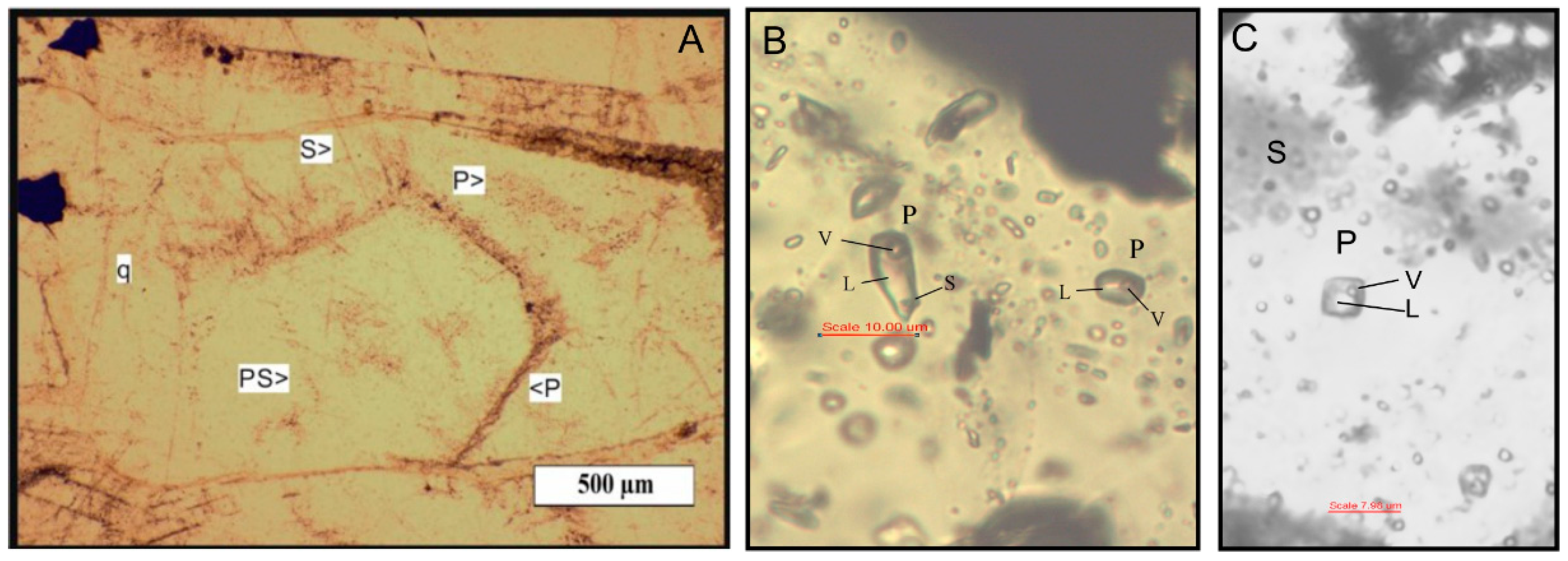
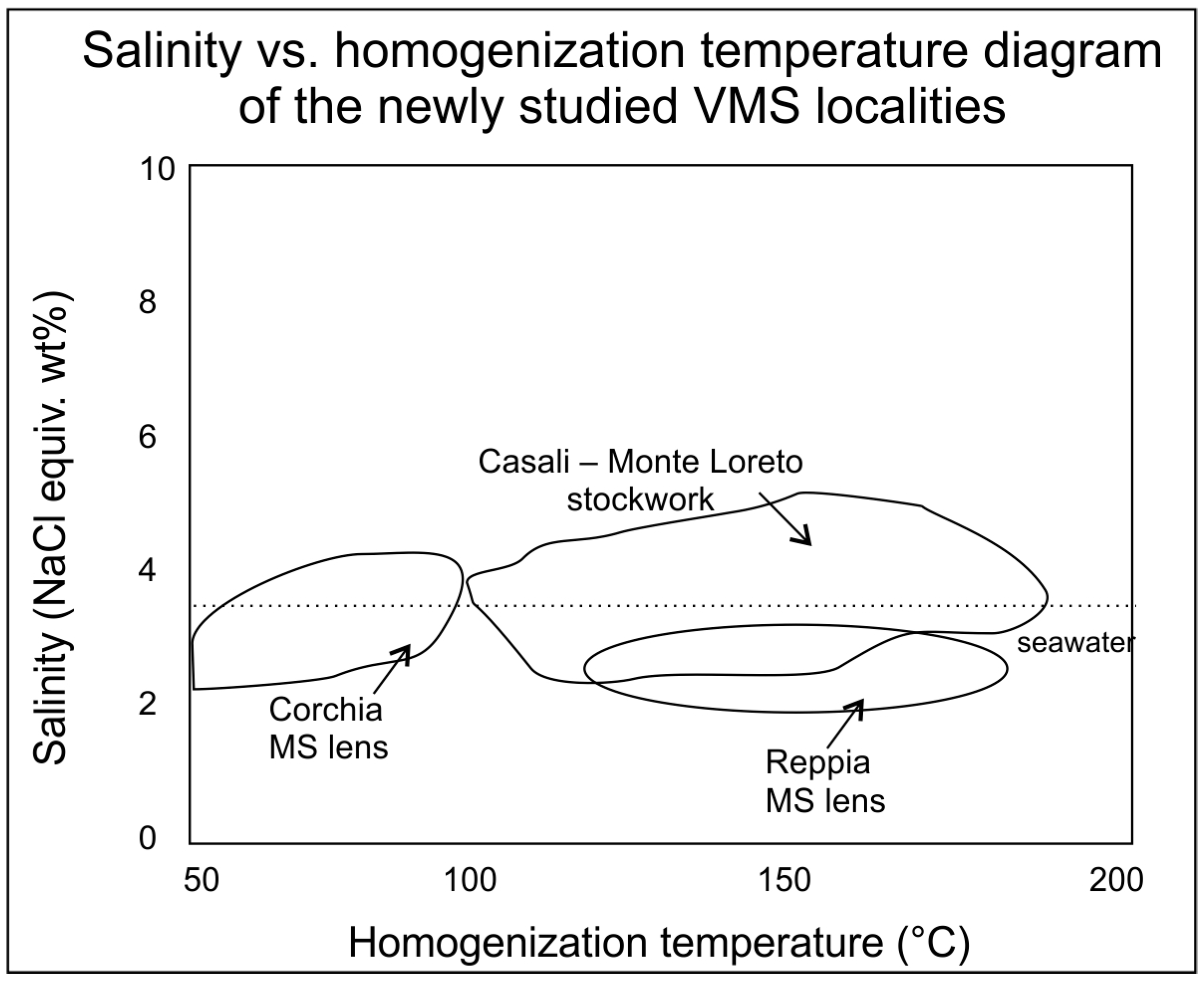
References
- Bodnar, R.J.; Lecumberri-Sanchez, P.; Moncada, D.; Steele-MacInnis, M. Fluid inclusions in hydrothermal ore deposits. In Treatise on Geochemistry, 2nd ed.; Elsevier: Oxford, UK, 2014; Volume 13, pp. 119–142. [Google Scholar]
- Herzig, P.M.; Hannington, M.D. Polymetallic massive sulphides at the modern seafloor: A review. Ore Geol. Rev. 1995, 10, 95–115. [Google Scholar] [CrossRef]
- Pirajno, F. Hydrothermal Processes and Mineral Systems; Springer: Dordrecht, The Netherlands, 2009; 1250p. [Google Scholar]
- Shanks, W.C.P.; Thurston, R. (Eds.) Volcanogenic Massive Sulfide Occurrence Model; U.S. Geological Survey Scientific Investigations Report 2010–5070–C; U.S. Geological Survey: Washington, DC, USA, 2012; 345p.
- Wilkinson, J.J. Fluid inclusions in hydrothermal ore deposits. Lithos 2001, 55, 229–272. [Google Scholar] [CrossRef]
- Yang, K.; Scott, S.D. Magmatic sources of volatiles and metals for volcanogenic massive sulfide deposits on modern and ancient seafloors: Evidence from melt inclusions. In Mineral Deposit Research: Meeting the Global Challenge; Mao, J., Bierlein, F.P., Eds.; Springer: Berlin/Heidelberg, Germany, 2005; pp. 715–718. [Google Scholar]
- Molli, G.; Crispini, L.; Mosca, P.; Piana, P.; Federico, L. Geology of the Western Alps-Northern Apennine junction area: A regional review. J. Virtual Explor. 2010, 36, 10. [Google Scholar] [CrossRef]
- Barrett, T.J. Review of stratigraphic aspects of the ophiolitic rocks and pelagic sediments of the Vara complex, North Apennines, Italy. Ofioliti 1982, 7, 3–46. [Google Scholar]
- Abbate, E.; Bortolotti, V.; Principi, G. Apennine ophiolites: A peculiar oceanic crust. In Tethyan Ophiolites; Ofioliti Special Issue; Rocci, G., Ed.; Pitagora Editrici: Bologna, Italy, 1980; Volume 1, pp. 59–96. [Google Scholar]
- Piccardo, G.B.; Rampone, E.; Romairone, A. Formation and composition of the oceanic lithosphere of the Ligurian Tethys: Inferences from the Ligurian ophiolites. Ofioliti 2002, 27, 145–161. [Google Scholar]
- Garuti, G.; Zaccarini, F. Assemblage and composition of Au, Ag and U minerals in Volcanic-Associated Massive Sulfide deposits of the Northern Apennine Ophiolites (Italy). Can. Mineral. 2005, 43, 935–950. [Google Scholar] [CrossRef]
- Garuti, G.; Bartoli, O.; Scacchetti, M.; Zaccarini, F. Geological setting and structural styles of Volcanic Massive Sulphide deposits in the Northern Apennines (Italy): Evidence for seafloor and sub-seafloor hydrothermal activity in unconventional ophiolites of the Mesozoic Tethys. Boletín Soc. Geológica Mex. 2008, 60, 121–145. [Google Scholar] [CrossRef]
- Zaccarini, F.; Garuti, G. Mineralogy and chemical composition of VMS deposits of northern Apennine ophiolites, Italy: Evidence for the influence of country rock type on ore composition. Mineral. Petrol. 2008, 94, 61–83. [Google Scholar] [CrossRef]
- Garuti, G.; Alfonso, P.; Zaccarini, F.; Proenza, J.A. Sulfur-isotope variations in sulphide minerals from massive sulphide deposits of the Northern Apennine ophiolites: Inorganic and biogenic constraints. Ofioliti 2009, 34, 43–62. [Google Scholar]
- Garuti, G.; Zaccarini, F.; Scacchetti, M.; Bartoli, O. The Pb-rich sulphide veins in the Boccassuolo ophiolite: Implications for the evolution of hydrothermal activity across the ocean-continent transition in the Ligurian Tethys (Northern-Apennine, Italy). Lithos 2011, 124, 243–254. [Google Scholar] [CrossRef]
- Kiss, G.B. Fluid inclusion study of the Boccassuolo VMS-related stockwork deposit (Northern Apennine ophiolites, Italy). Geol. Croat. 2015, 68, 285–302. [Google Scholar] [CrossRef]
- Kiss, G.B.; Bendő, Z.; Garuti, G.; Zaccarini, F.; Király, E.; Molnár, F. Reconstruction of hydrothermal processes in the Cyprus type Fe-Cu-Zn deposits of the Italian Northern Apennines: Results of combined fluid inclusion microthermometry, SEM-CL im-aging and trace element analyses by LA-ICP-MS. Minerals 2021, 11, 165. [Google Scholar] [CrossRef]
- Bertolani, M. I giacimenti cupriferi nelle ofioliti di Sestri Levante (Liguria). Period. Mineral. 1952, 21, 149–170. [Google Scholar]
- Hall, D.L.; Sterner, S.M.; Bodnar, R.J. Freezing point depression of NaCl-KCl-H2O solutions. Econ. Geol. 1988, 83, 197–202. [Google Scholar] [CrossRef]
- Sun, Q.; Zhao, L.; Li, N.; Liu, J. Raman spectroscopic study for the determination of Cl-concentration (molarity scale) in aqueous solutions: Application to fluid inclusions. Chem. Geol. 2010, 272, 55–61. [Google Scholar] [CrossRef]
- Guillaume, D.; Teinturier, S.; Dubessy, J.; Pironon, J. Calibration of methane analysis by Raman spectroscopy in H2O–NaCl–CH4 fluid inclusions. Chem. Geol. 2003, 194, 41–49. [Google Scholar] [CrossRef]
- Kranidiotis, P.; MacLean, W.H. Systematics of chlorite alteration at the Phelps Dodge massive sulfide deposit, Matagami, Quebec. Econ. Geol. 1987, 82, 1898–1911. [Google Scholar] [CrossRef]
- Cathelineau, M.; Izquierdo, G. Temperature-Composition relationships of authigenic micaceous minerals in the Los Azufres geothermal system. Contrib. Mineral. Petrol. 1988, 100, 418–428. [Google Scholar] [CrossRef]
- Zang, W.; Fyfe, W.S. Chloritization of the hydrothermally altered bedrock at the Igarapé Bahia gold deposit, Carajás, Brazil. Miner. Depos. 1995, 30, 30–38. [Google Scholar] [CrossRef]
- Inoue, A.; Meunier, A.; Patrier-Mas, P.; Rigault, C.; Beaufort, D.; Vieillard, P. Application of chemical geothermometry to low-temperature trioctahedral chlorites. Clays Clay Mineral. 2009, 57, 371–382. [Google Scholar] [CrossRef]
- Bourdelle, F.; Parra, T.; Chopin, C.; Beyssac, O. A new chlorite geothermometer for diagenetic to low-grade metamorphic conditions. Contrib. Mineral. Petrol. 2013, 165, 723–735. [Google Scholar] [CrossRef]
- Lanari, P.; Wagner, T.; Vidal, O. A thermodynamic model for di-trioctahedral chlorite from experimental and natural data in the system MgO–FeO–Al2O3–SiO2–H2O: Applications to P–T sections and geothermometry. Contrib. Mineral. Petrol. 2014, 167, 968. [Google Scholar] [CrossRef]
- Ballentine, C.J.; Burgess, R.; Marty, B. Tracing fluid origin, transport and interaction in the crust. Rev. Mineral. Geochem. 2002, 47, 539–614. [Google Scholar] [CrossRef]
- Spötl, C.; Vennemann, T.W. Continuous–flow isotope ratio mass spectrometric analysis of carbonate minerals. Rapid Commun. Mass Spectrom. 2003, 19, 1004–1006. [Google Scholar] [CrossRef] [PubMed]
- Czuppon, G.; Ramsay, R.R.; Özgenc, I.; Demény, A.; Gwalani, L.G.; Rogers, K.; Eves, A.; Papp, L.; Palcsu, L.; Berkesi, M.; et al. Stable (H, O, C) and noble-gas (He and Ar) isotopic compositions from calcite and fluorite in the Speewah dome, Kimberley region, western Australia: Implications for the conditions of crystallization and evidence for the influence of crustal-fluid mixing. Mineral. Petrol. 2014, 108, 759–775. [Google Scholar] [CrossRef]
- Demény, A.; Czuppon, G.; Kern, Z.; Leél-Őssy, S.; Németh, A.; Szabó, M.; Tóth, M.; Wu, C.-C.; Shen, C.-C.; Molnár, M.; et al. Recrystallization-induced oxygen isotope changes in inclusion-hosted water of speleothems—Paleoclimatological implications. Quatern. Int. 2016, 415, 25–32. [Google Scholar] [CrossRef]
- Zane, A.; Weiss, Z. A procedure for classifying rock-forming chlorites based on microprobe data. Rend. Lincei Sci. Fis. Nat. 1998, 9, 51–56. [Google Scholar] [CrossRef]
- Duan, Z.; Mao, S. A thermodynamic model for calculating methane solubility, density and gas phase composition of methane-bearing aqueous fluids from 273 to 523 K and from 1 to 2000 bar. Geochim. Cosmochim. Acta 2006, 70, 3369–3386. [Google Scholar] [CrossRef]
- Friedman, I.; O’Neil, J.R. Compilation of stable isotope fractionation factors of geochemical interest. In Data of Geochemistry; USGS Numbered Series, Professional Paper 440-KK; US Government Printing Office: Washington, DC, USA, 1977. [Google Scholar]
- Sano, Y.; Marty, B.; Burnard, P. Noble gases in the atmosphere. In The Noble Gases as Geochemical Tracers; Burnard, P., Ed.; Springer: Berlin/Heidelberg, Germany, 2013; pp. 17–31. [Google Scholar]
- Barrie, C.T.; Hannington, M.D. Introduction: Classification of VMS deposits based on host rock composition. Rev. Econ. Geol. 1999, 8, 2–10. [Google Scholar]
- Steele-Macinnis, M.; Han, L.; Lowell, R.P.; Rimstidt, J.D.; Bodnar, R.J. Quartz precipitation and fluid inclusion characteristics in sub-seafloor hydrothermal systems associated with volcanogenic massive sulphide deposits. Centr. Eur. J. Geosci. 2012, 4, 275–286. [Google Scholar]
- Etiope, G.; Schoell, M. Abiotic gas: Atypical but not rare. Elements 2014, 10, 291–296. [Google Scholar] [CrossRef]
- Foustoukos, D.I.; Seyfried, W.E. Fluid phase separation processes in submarine hydrothermal systems. Rev. Mineral. Geochem. 2007, 65, 213–239. [Google Scholar] [CrossRef]
- Nehlig, P. Salinity of oceanic hydrothermal fluids: A fluid inclusion study. Earth Planet. Sci. Lett. 1991, 102, 310–325. [Google Scholar] [CrossRef]
- Barrett, T.J.; Friedrichsen, H. Stable isotopic composition of atypical ophiolitic rocks from east Liguria, Italy. Chem. Geol. 1989, 80, 71–84. [Google Scholar] [CrossRef]
- Tornos, F. Environment of formation and styles of volcanogenic massive sulfides: The Iberian Pyrite Belt. Ore Geol. Rev. 2006, 28, 259–307. [Google Scholar] [CrossRef]
- Taylor, H.P., Jr. Oxygen isotope studies of hydrothermal mineral deposits. In Geochemistry of Hydrothermal Ore Deposits; Barnes, H.L., Ed.; Holt, Rinehart and Wiston: New York, NY, USA, 1967; pp. 109–142. [Google Scholar]
- Kendrick, M.A.; Burnard, P. Noble gases and halogens in fluid inclusions: A journey through the earth’s crust. In The Noble Gases as Geochemical Tracers—Advances in Isotope Geochemistry; Burnard, P., Ed.; Springer: Berlin/Heidelberg, Germany, 2013; pp. 319–370. [Google Scholar]
- Nier, A.O. A redetermination of the relative abundances of the isotopes of carbon, nitrogen, oxygen, argon, and potassium. Phys. Rev. 1950, 77, 789–793. [Google Scholar] [CrossRef]
- Sano, Y.; Wakita, H. Geographical distribution of 3He/4He ratios in Japan: Implications for arc tectonics and incipient magmatism. J. Geophys. Res. Solid Earth 1985, 90, 8729–8741. [Google Scholar] [CrossRef]
- Sano, Y.; Marty, B. Origin of carbon in fumarolic gas from island arcs. Chem. Geol. 1995, 119, 265–274. [Google Scholar] [CrossRef]
- Graham, D.W. Noble Gas Isotope Geochemistry of Mid-Ocean Ridge and Ocean Island Basalts: Characterization of Mantle Source Reservoirs. Rev. Mineral. Geochem. 2002, 47, 247–317. [Google Scholar] [CrossRef]
- Yang, F.; Li, Q.; Yang, C.; Zhang, Z. A combined fluid inclusion and S–H–O–He–Ar isotope study of the Devonian Ashele VMS-type copper–zinc deposit in the Altay orogenic belt, northwest China. J. Asian Earth Sci. 2018, 161, 139–163. [Google Scholar] [CrossRef]
- Yang, C.; Zhang, B.; Yang, F.; Li, Q.; Wang, Y. Zircon U–Pb age, fluid inclusion, and H–C–O–He–Ar–S isotopic compositions as an index to the VMS-type mineralization: A case study from the Wulasigou polymetallic deposit, Altay Orogenic Belt, Northwest China. J. Geochem. Expl. 2021, 222, 106720. [Google Scholar] [CrossRef]
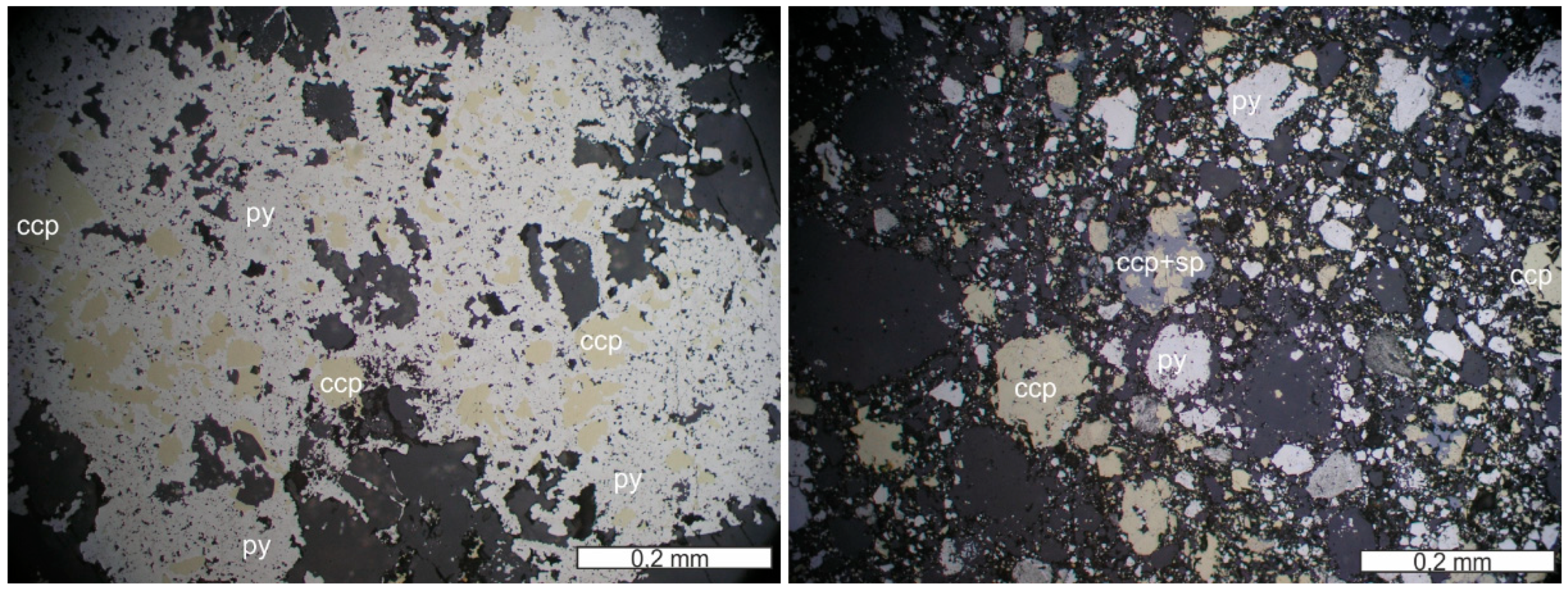


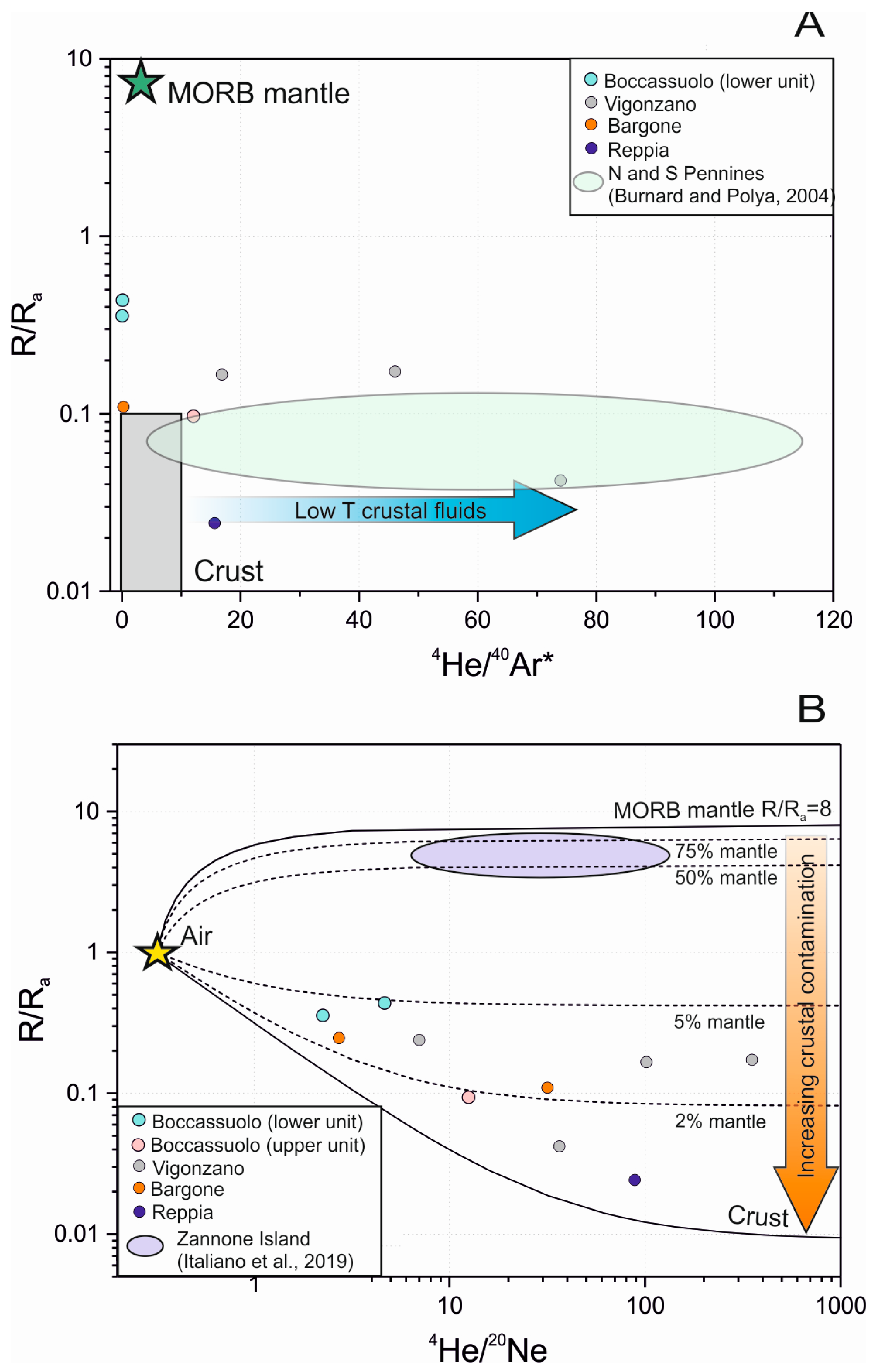
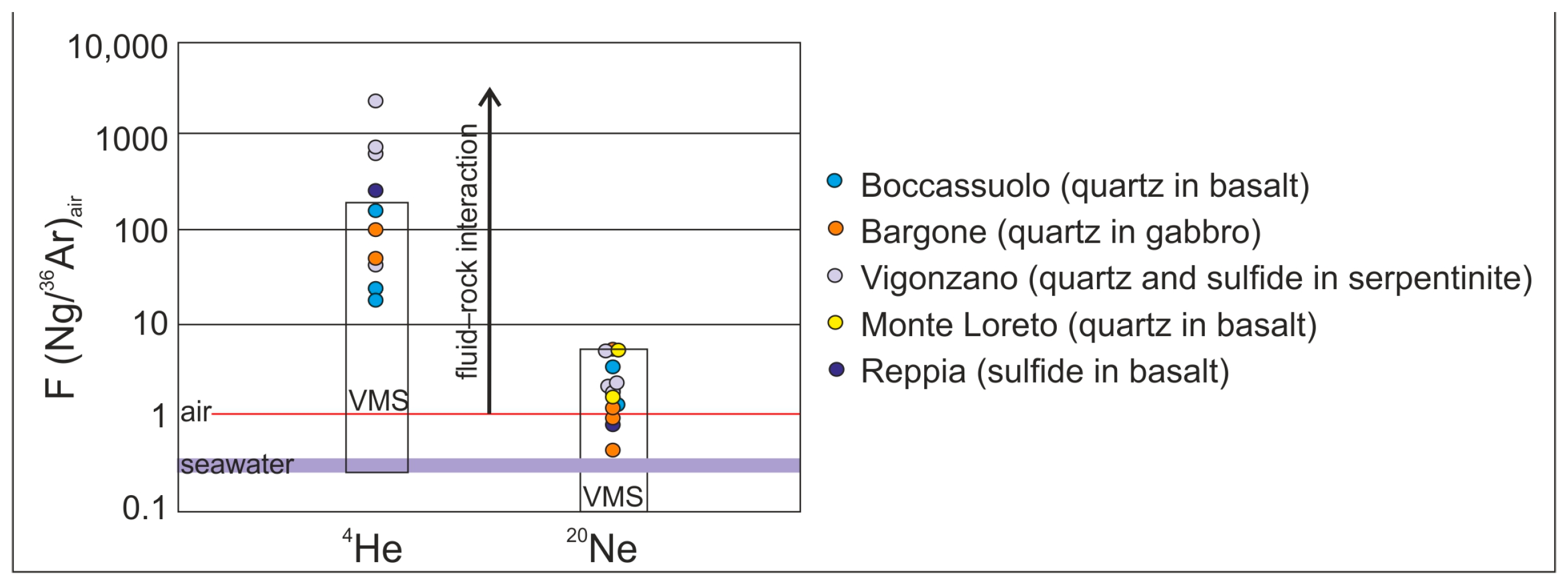
| Location | Type | Ore Minerals | Gangue Minerals | Accessories |
|---|---|---|---|---|
| Bargone | 4b | Pyrite, chalcopyrite (sphalerite) | Quartz, prehnite (calcite, chlorite) | Bornite, covellite, Mn-minerals, Pb-selenides |
| Boccassuolo | 4c | Pyrite, chalcopyrite, sphalerite | Quartz, calcite, chlorite, epidote, titanite | Galena, rutile, zircon |
| Campegli | 4b | Pyrite, chalcopyrite (sphalerite) | Quartz, chlorite, epidote (pumpellyite) | Monazite, other REE minerals |
| Casali–Monte Loreto | 4c | Pyrite, chalcopyrite sphalerite | Quartz, calcite, chlorite, epidote, titanite (actinolite, prehnite, pumpellyite) | Rutile/anatase |
| Corchia | 3 | Pyrite, chalcopyrite sphalerite, pyrrhotite | Calcite, quartz, chlorite, siderite, clay minerals, titanite | Linnéite, native gold, acanthite, uraninite, barite, REE minerals, magnetite, freibergite, galena, smithsonite, hydroromarchite |
| Reppia | 1, 2, 3, 4c * | Pyrite, chalcopyrite, pyrrhotite (sphalerite) | Quartz, calcite, chlorite, siderite | Limonite |
| Vigonzano | 4a | Pyrite, chalcopyrite, pyrrhotite | quartz, calcite, Chlorite, siderite, epidote, titanite, prehnite | Marcasite, millerite, chromite, magnetite, hematite, zircon, serpentine minerals |
| Al2O3 | MgO | K2O | CaO | Cr2O3 | Na2O | MnO | SiO2 | TiO2 | NiO | FeO | Al (IV) | XFe | T (°C) | ||
|---|---|---|---|---|---|---|---|---|---|---|---|---|---|---|---|
| Det. lim. | 0.013 | 0.011 | 0.012 | 0.016 | 0.021 | 0.015 | 0.023 | 0.021 | 0.029 | 0.032 | 0.024 | ||||
| Reppia, chlorite (n = 8) | Min | 13.282 | 16.280 | b.d.l. | 0.077 | b.d.l. | b.d.l. | 0.274 | 29.263 | b.d.l. | b.d.l. | 22.194 | 0.824 | 0.392 | 184 |
| Max | 17.488 | 18.985 | 0.037 | 0.495 | b.d.l. | 0.030 | 0.471 | 31.475 | 0.395 | 0.071 | 23.995 | 0.953 | 0.442 | 214 | |
| Mean | 16.172 | 17.606 | 0.035 | 0.263 | n.a. | 0.025 | 0.367 | 30.043 | 0.153 | 0.064 | 23.076 | 0.883 | 0.419 | 198 | |
| St. dev. | 1.393 | 1.005 | 0.003 | 0.122 | n.a. | 0.007 | 0.072 | 0.826 | 0.163 | 0.010 | 0.570 | 0.047 | 0.019 | 10 | |
| Campegli, chlorite (n = 42) | Min | 15.539 | 13.788 | 0.012 | 0.015 | b.d.l. | b.d.l. | 0.279 | 26.578 | b.d.l. | b.d.l. | 11.784 | 0.820 | 0.203 | 222 |
| Max | 19.979 | 25.644 | 0.062 | 1.258 | 0.206 | 0.059 | 0.819 | 31.758 | 0.199 | 0.141 | 26.950 | 1.147 | 0.515 | 302 | |
| Mean | 17.691 | 20.648 | 0.023 | 0.165 | 0.066 | 0.027 | 0.570 | 29.389 | 0.056 | 0.051 | 18.658 | 1.001 | 0.333 | 242 | |
| St. dev. | 0.858 | 2.873 | 0.015 | 0.211 | 0.052 | 0.014 | 0.165 | 1.234 | 0.042 | 0.025 | 3.766 | 0.082 | 0.074 | 19 | |
| Monte Loreto, chlorite (n = 11) | Min | 14.922 | 14.848 | 0.017 | b.d.l. | b.d.l. | b.d.l. | 0.351 | 25.788 | b.d.l. | b.d.l. | 19.843 | 1.131 | 0.466 | 302 |
| Max | 18.799 | 19.261 | 0.042 | 0.427 | 0.096 | 0.053 | 0.454 | 31.194 | 0.075 | 0.082 | 27.255 | 1.238 | 0.503 | 337 | |
| Mean | 18.162 | 15.865 | 0.029 | 0.125 | 0.041 | 0.034 | 0.404 | 26.886 | 0.055 | n.a. | 25.681 | 1.179 | 0.484 | 318 | |
| St. dev. | 1.162 | 1.260 | 0.010 | 0.202 | 0.029 | 0.012 | 0.036 | 1.555 | 0.016 | n.a. | 2.147 | 0.032 | 0.013 | 10 |
| Location | Calcite | Fluid | ||
|---|---|---|---|---|
| δ13 CPDB | δ18 OSMOW | δ18 OSMOW | ||
| Bargone (n = 9) | Min | −2.79 | 15.18 | −0.32 |
| Max | −0.26 | 16.52 | 0.99 | |
| Mean | −1.04 | 15.89 | 0.38 | |
| St. dev. | 0.8 | 0.43 | 0.43 | |
| Boccassuolo (upper block, n = 8) | Min | −0.79 | 15.87 | −3.67 |
| Max | −0.01 | 18.51 | −1.07 | |
| Mean | −0.21 | 16.63 | −2.92 | |
| St. dev. | 0.28 | 0.83 | 0.81 | |
| Boccassuolo (lower block, n = 6) | Min | 0.14 | 22.01 | 3.57 |
| Max | 0.71 | 22.74 | 4.28 | |
| Mean | 0.37 | 22.38 | 3.94 | |
| St. dev. | 0.21 | 0.29 | 0.28 | |
| Corchia (n = 9) | Min | −3.07 | 20.92 | −0.04 |
| Max | −1.85 | 21.76 | 0.78 | |
| Mean | −2.38 | 21.24 | 0.28 | |
| St. dev. | 0.46 | 0.39 | 0.39 | |
| Monte Loreto (n = 7) | Min | −6.96 | 14.97 | 0.46 |
| Max | −0.88 | 15.95 | 1.42 | |
| Mean | −3.75 | 15.43 | 0.91 | |
| St. dev. | 2.96 | 0.42 | 0.41 | |
| δD | |
|---|---|
| Bargone, quartz | −39.38 |
| −47.01 | |
| Boccassuolo (upper block), quartz | −41.15 |
| Boccassuolo (lower block), quartz | −65.12 |
| −42.99 | |
| −47.14 | |
| Corchia, quartz | −42.39 |
| Monte Loreto, quartz | −44.05 |
| Vigonzano, quartz | −40.85 |
| −30.39 |
Disclaimer/Publisher’s Note: The statements, opinions and data contained in all publications are solely those of the individual author(s) and contributor(s) and not of MDPI and/or the editor(s). MDPI and/or the editor(s) disclaim responsibility for any injury to people or property resulting from any ideas, methods, instructions or products referred to in the content. |
© 2022 by the authors. Licensee MDPI, Basel, Switzerland. This article is an open access article distributed under the terms and conditions of the Creative Commons Attribution (CC BY) license (https://creativecommons.org/licenses/by/4.0/).
Share and Cite
Kiss, G.B.; Molnár, K.; Benkó, Z.; Skoda, P.; Kapui, Z.; Garuti, G.; Zaccarini, F.; Palcsu, L.; Czuppon, G. Tracing the Source of Hydrothermal Fluid in Ophiolite-Related Volcanogenic Massive Sulfide Deposits: A Case Study from the Italian Northern Apennines. Minerals 2023, 13, 8. https://doi.org/10.3390/min13010008
Kiss GB, Molnár K, Benkó Z, Skoda P, Kapui Z, Garuti G, Zaccarini F, Palcsu L, Czuppon G. Tracing the Source of Hydrothermal Fluid in Ophiolite-Related Volcanogenic Massive Sulfide Deposits: A Case Study from the Italian Northern Apennines. Minerals. 2023; 13(1):8. https://doi.org/10.3390/min13010008
Chicago/Turabian StyleKiss, Gabriella B., Kata Molnár, Zsolt Benkó, Péter Skoda, Zsuzsanna Kapui, Giorgio Garuti, Federica Zaccarini, László Palcsu, and György Czuppon. 2023. "Tracing the Source of Hydrothermal Fluid in Ophiolite-Related Volcanogenic Massive Sulfide Deposits: A Case Study from the Italian Northern Apennines" Minerals 13, no. 1: 8. https://doi.org/10.3390/min13010008
APA StyleKiss, G. B., Molnár, K., Benkó, Z., Skoda, P., Kapui, Z., Garuti, G., Zaccarini, F., Palcsu, L., & Czuppon, G. (2023). Tracing the Source of Hydrothermal Fluid in Ophiolite-Related Volcanogenic Massive Sulfide Deposits: A Case Study from the Italian Northern Apennines. Minerals, 13(1), 8. https://doi.org/10.3390/min13010008








